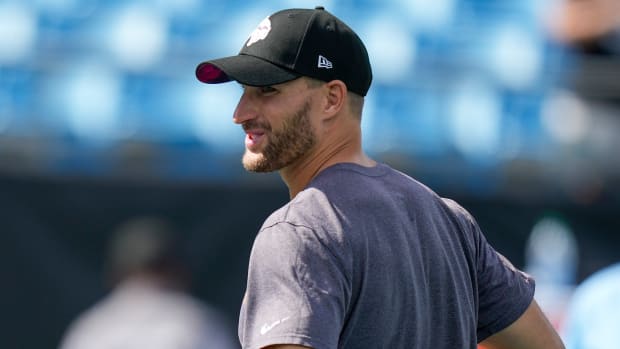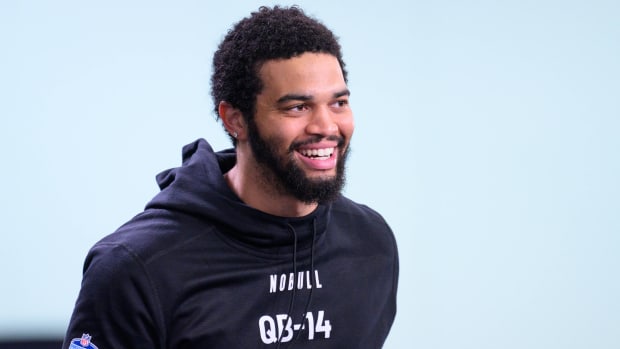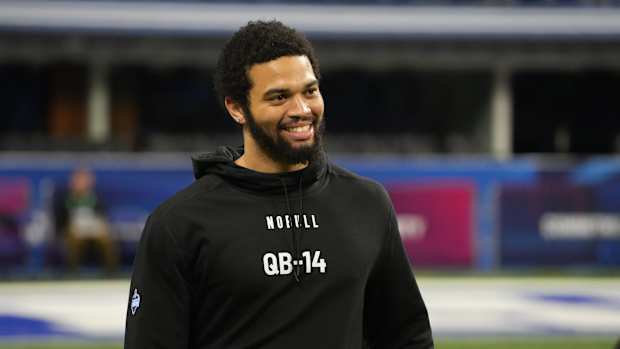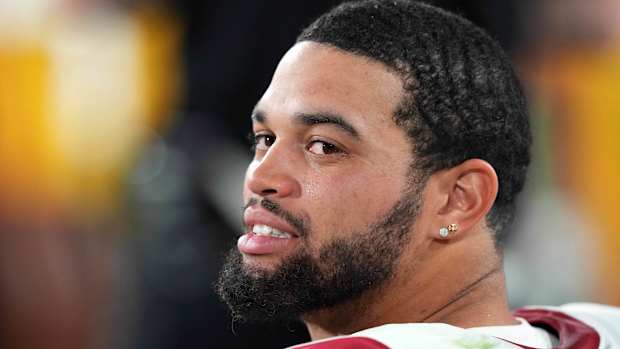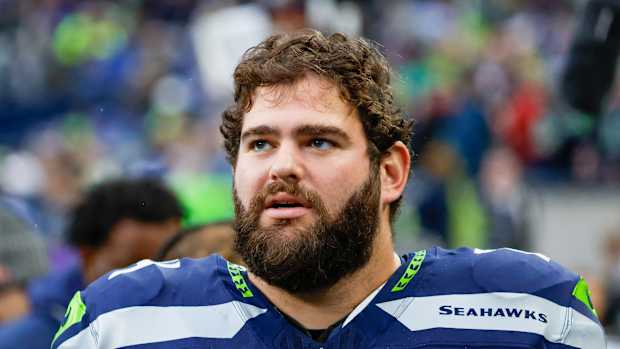A rule change as drastic as the one adopted Tuesday at the NFL owners meetings naturally will impact the way the game is played and also will influence personnel.
The Bears will be like any NFL team as they attempt to take advantage of a kickoff rule allowing for more and different types of returns.
The rule has the ball kicked from the 35-yard line but coverage players are lined up 25 yards ahead of the kicker. Any ball entering the end zone in the air can be downed and the offense takes over at the 40-yard line on a touchback but a ball not in the end zone or one bouncing or rolling to the end zone must be returned or downed for a touchback that moves it to the 20-yard line.
A drastic change comes with alignment as the return team must have nine players between their 30 and 35-yard line.
Kicks out of bounds are placed at the 40, fair catches are not allowed and an onside kick is allowed only in the fourth quarter and must be announced prior to the attempt.
It's going to make for what basically looks like a running play from scrimmage except the kicks are going to become more of an art form except they're triggered by extremely high kickoffs or squibs.
As a result, a kick returner who can start and stop or negotiate traffic better is more likely to be preferable to someone with blazing speed. A running back would be a better choice in most instances than a wide receiver.
Ironically, in a year when the most famous return man of all time, former Bears receiver Devin Hester, goes into the Hall of Fame the rule has been changed to make players of similar skills less effective.
Here are the Winners and Losers on the Bears from the kickoff rule change.
Winners
RB Khalil Herbert
The Bears starting running back last season might find he's relegated to a second-string status this year. It doesn't necessarily mean he'll be less active. Prior to becoming the starting running back, Herbert was an effective kick returner. He averages 24.9 yards for his career on 32 returns, but as a running back he'd be more equipped to handle the crowded return situations and then break free for bigger gains. Running backs are used to gaining speed immediately or after a few steps in a crowd. Wide receivers were used in the old style of returns because they are fast immediately in open space, but that rule change makes a player who can gain speed in a crowd like a back preferable. If Herbert shows he can be effective doing this and as the second running back, he can greatly improve his chances for a second contract in Chicago.
WR Tyler Scott
Sure, he's a wide receiver, but Scott used to be a running back before he converted to wide receiver. So he might be the best combination of all in that he has the knowledge of how to negotiate crowded situations and speed once he breaks free. Scott also had some work as a kick returner last year, making one return and in preseason four returns for a 27.3-yard average.
RB Travis Homer
The Bears signed Homer in free agency talking about his receiving ability out of the backfield and special teams prowess. Homer's services went unused as a backup running back on offense last year as he had only six plays. He was involved in 253 special teams plays and did not return kicks. However, he was a kick returner in the past at Seattle with a 24.7-yard average for 18 returns. A player with running back and kick return skills first well into the new kickoff world of running in a crowd.
RB Roschon Johnson
Johnson might not be a return man but can do it. He averaged only 17.9 yards on eight college returns, but he still played on 152 special teams plays last year and in college had been an effective coverage man. He also was a player who blocked for the returner. Johnson can be one of two deep backs on kick returns. Since nine players must be be up and two are allowed back, and defenders on returns are closer after the ball is kicked, it would be almost essential to have two players back returning the kicks. The two-deep look ratherr than the one-deep look will be the likely choice. Players who are able to also block if they are not the return man on a particular kick are even better equipped to help break returns. Johnson would be ideal for this role as the No. 2 return man/possible blocker.
FB Khari Blasingame
Blasingame is on the secocnd year of a two-year contract and had 210 special teams plays so he will be on return team, anyway. That is, he will be if Shane Waldron's offense includes a fullback. During Waldron's time With Seattle, there was a fullback type on the roster for only six games. The rest of the time they had no fullback. However, Blasingame serves a purpose on special teams as a blocker with power and speed. He'd be an ideal fit on return teams provided he has a roster spot.
LB Micah Baskerville
A practice squad player most of last year, Baskerville has a better chance to make the roster now because there will be more kick returns and they'll be in different circumstances than before. The coverage men don't need to run as far now and there will be more crowds or scrum situations, decreasing the value of a defensive back in relation to a good-tackling linebacker. The Bears may be forced to carry a sixth linebacker on the 53-man roster with starters Jack Sanborn, T.J. Edwards and Tremaine Edmunds and backups Noah Sewell and Amen Ogbongbemiga because of that special teams coverage need.
Losers
WR Velus Jones Jr.
Jones hasn't been a punt returner because he can't field them. He has proven this at the cost of two defeats. He has only 11 pass receptions in two seasons, but has run it from scrimmage 17 times for a 9-yard average and a TD. The real skill Jones has contributed is kick returns with a 27.4-yard average on 38 returns, placing him near the top of the league since he came into the league. The problem with his return style is he is like most wide receivers. He uses that 4.31-second speed in the 40 to build up a huge head of steam and advance downfield before the coverage reaches him. With coverage players starting out only 5 yards away from his blocking wall at the return team's 40, Jones' speed is negated. It is further negated with the returns taking on more of a running play look with the ball carrier needing to negotiate crowds. Jones has been effective on running plays but those have been on end-around plays. They are surprise plays where he gets the ball in a specific spot and is going around the end to a more wide open area. The returns now will be in crowds and the return man is not a surprise ball carrier the way a wide receiver on an end-around is, so he loses that extra few steps with coverage players knowing where to focus. It's going to be on Jones to prove he actually belongs on the roster as a receiver this year and not simply as a kick returner because the rules are likely to counter his return abilities.
TE Cole Kmet
Not many starters want to be on special teams but a big player who can move is going to be valued on special teams blocking even more now. So Kmet, as well as Gerald Everett, might be required to play on kick return. They can block on the move and in space better than most offensive linemen because they do it so much. The team benefits but the starting tight ends are not really going to benefit from wasting reps on kick return.
K Cairo Santos
Santos will need to learn a new skill now and get the ball down on the ground but not to the end zone or pop it up higher. This makes his job tougher, but now his role as a last line of defense on kickoffs is more likely to result in embarrassing situations. If a back returning a kick pops through the closer line of defense, the only one left to stop a kick return is the kicker. Before, players covering kicks could be layered or dispersed better across the field and made it less likely a kicker was going to need to be involved in stopping a return. Now, coverage men are going to be engaged almost immediately by blockers and it's going to be up to the kicker to get it done. Look for the Bears to try and get punter Trenton Gill plenty of work learning to make the new style of kickoffs. Gill kicked off 13 times last year so he already has been used this way. He's 6-foot-4, 219 pounds and no doubt could do a better job as a last line of defense than a 5-8, 175-pound kicker like Santos.
Twitter: BearDigest@BearsOnMaven
